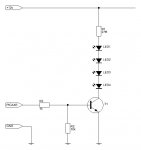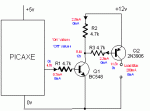Dear Friends,
I'm trying to use a 2N3906 (pnp transistor) as a Switch between 5V and 12V, this using the pulse Low or High of my PICAXE to activate or desactivate it.
The problem is that my transistor all the time is saturated (active), I tried to make some numbers to calculated the resistors but up to now I dont found a solution.
The problem is that I already made the PCB with all de LED installed, for this reason I need to get the 12 V at the transistor collector.
I don´t use relays because my circuit works with 8 Mhz then it could be damaged.
I don't use optoacoplers because is too late to make big changes to my desing.
Please help me, because this is very urgent for my.
Here is the circuit that I'm using.
Thanks in advance,
I'm trying to use a 2N3906 (pnp transistor) as a Switch between 5V and 12V, this using the pulse Low or High of my PICAXE to activate or desactivate it.
The problem is that my transistor all the time is saturated (active), I tried to make some numbers to calculated the resistors but up to now I dont found a solution.
The problem is that I already made the PCB with all de LED installed, for this reason I need to get the 12 V at the transistor collector.
I don´t use relays because my circuit works with 8 Mhz then it could be damaged.
I don't use optoacoplers because is too late to make big changes to my desing.
Please help me, because this is very urgent for my.
Here is the circuit that I'm using.
Thanks in advance,
Attachments
-
58.8 KB Views: 176




